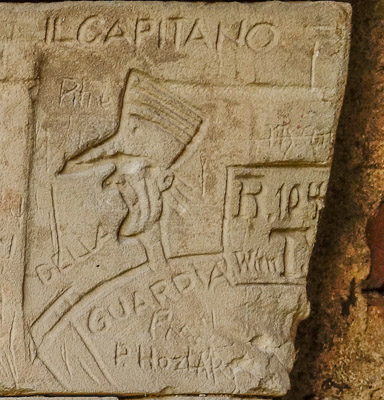Veliagate
by Brian Hayes
Published 28 February 2008

Zeno of Elea—the philosopher of footraces that never end and arrows that never reach their target—seems a figure so lost in abstractions and infinities that it’s hard to imagine him living in some particular place and time. But Elea was a real town, a sixth-century B.C.E. Greek settlement on the Tyrrhenian coast of Italy. The site is now the Italian village of Velia, about 100 kilometers south of Naples.
The massive stonework wall and gate shown above, known as the Porta Rosa, lies atop a ridge separating two neighborhoods of ancient Elea. I visited several years ago, and ever since then I’ve been perplexed by that gate. I’m now going to be writing about Zeno’s hometown for an upcoming American Scientist column, and so I thought I would ask the world for help in resolving the mystery of Veliagate.
What puzzles me, of course, is the eyebrow above the arch. It looks as if the gate was originally built a meter higher, and then lowered. Why would anyone do that? I can imagine how erosion of the ridge and the roadway might have made the opening taller than it was at the outset—but what’s the harm of that? And if the city engineers did want to maintain the original headroom, wouldn’t it be much easier to build up the roadway than to lower the arch?
Or am I wrong that the two arches represent two stages in the history of the gate? Maybe the “eyebrow” is really some sort of reinforcement?
I should mention that the Porta Rosa also has a bit of topological interest. It is built at a saddle point in the ridge. The lower passage (seen in the photograph) connects two valleys, while the roadway crossing above the arch links two hilltops.
Finally, I have another question about Greek mathematics. The big literary figures of ancient Greece were mostly Athenians, and so were the historians and political writers and the major philosophers. But when it comes to the nerdy Greeks, they seem to have been scattered all over the Mediterranean world. Euclid, Diophantus and Hypatia were Alexandrians; Pythagoras came from the island of Samos; Archimedes lived in Syracuse, on Sicily; and Zeno, as already noted, was Italian. Coincidence, or shall we speculate about the different intellectual environments of the center and the periphery?
Responses from readers:
Please note: The bit-player website is no longer equipped to accept and publish comments from readers, but the author is still eager to hear from you. Send comments, criticism, compliments, or corrections to brian@bit-player.org.
Publication history
First publication: 28 February 2008
Converted to Eleventy framework: 22 April 2025




A discharging arch, maybe? (http://en.wikipedia.org/wiki/Discharging_arch)
The geographical distribution of the Greek mathematicians you mention is mostly, it seems to me, a function of history. Athens was the intellectual capital of the Mediterranean for a very short time, roughly the 5th century BCE. It never recovered from its defeat in the Peloponnesian War (~400BCE), and soon after became a pretty insignificant backwater.
Almost all of the Greeks on your list, however, lived after the fall of Athens, in the Hellenistic period, roughly defined as the time after Alexander the Great conquered what was then the known world (~mid 4th cen. BCE) but before the rise of Rome. Alexander’s armies carried Classical civilization to many hitherto neglected parts of the Mediterranean, so that centers of wealth and culture emerged everywhere. Most notably, Alexander established the eponymous Alexandria, where the equally eponymous library was built after his death.
So it’s no surprise that most of these Greek mathematicians were not Athenian, since they lived long after Athens lost its cultural and intellectual credentials. Neither is it a surprise that so many came from Alexandria, since the presence of the library turned this city into the Hellenistic world’s center of learning.
Two of the more influential Greeks on your list, I’ll admit, did indeed live around the heyday of Classical Athens: Pythagoras and Zeno. It’s possible, though I’m just speculating, that Pythagoras stayed away from Athens because of his eccentric religious views, which would probably not have been tolerated. Zeno is harder to explain. Maybe he just liked it better in Italy…
- Igor
@ Igor: Interesting point. So I revise my question: Why did the nerdy Greeks flourish so much later than the literati?
That is an interesting question. It is a big one with few facts to support solid arguments, so let’s indulge with wild speculations. Maybe some “critical mass” of population (besides some level of welfare) is necessary for sciences to develop; arts and humanities are not easy, but math and sciences are hard.
I’m with D. Eppstein with the probable functional purpose of the “eyebrow”. However, many of these Greek antiquities have been rebuilt at various times including recent times, (see the Island of Rhodes and reconstruction of fortifications). Complicating understanding when something was actually built and how with today’s view of what is built is the reuse of building materials both historically and in reconstruction efforts. It was very common for Roman builders to fill arched spans with a variety of materials that did not directly contribute to structural integrity but did become part of the form and purpose of the structure.
So in looking at the picture, I can see some evidence where stones may have been original and others that may have been added at later periods. Which could support both views; that the eyebrow is the original arch and the later additions used it to improve structural soundness using the principal D. Eppstein identified. Or, that the eyebrow was planned from the start to be formed to take advantage of the principal.
I do note that the lower arch is much “tighter” than the upper arch but am myself not schooled enough to differentiate the meaning that this could present except that it may signify two different efforts of construction by builders with different tools and skills.
Re: nerdy Greeks.
Let me name-drop Alexander the Great one more time. One of his major accomplishments was a partial synthesis of Greek and Persian cultures after centuries of animosity and warfare between those two peoples. It’s plausible that this resulted in the Greeks being introduced, for the first time, to the Persian mathematical canon, and this might have been just the thing to jump-start Greek mathematics. But rms is quite right; any theories on this topic are going to be almost entirely speculative, this one included…
Thales of Miletus was earlier. Perhaps it is due to the incorporation and succeeding of earlier work by later authors.
Pure speculation … science is a meritocracy, so it’s done by the “outside” crowd, who are normally denied access to the “inside” of society. The “inside” crowd does literature and law. How many members of the Institute for Advanced study come from the center of American society?
As for nerdy timeliness, wasn’t the Newtonian revolution after the Elizabethan era? Maybe there are spare brain cells around that can’t be turned to literature due to political reasons.